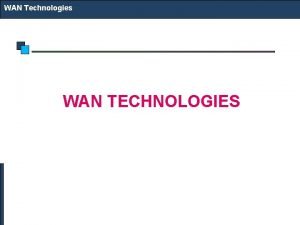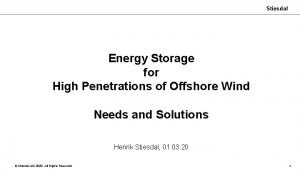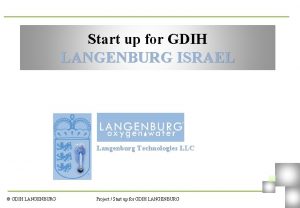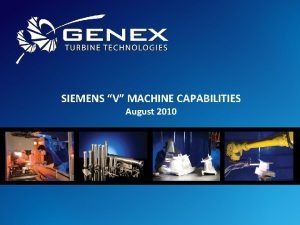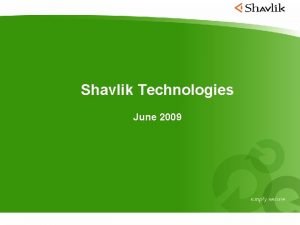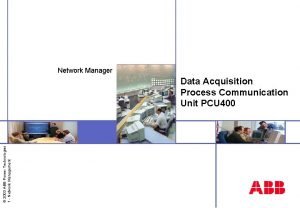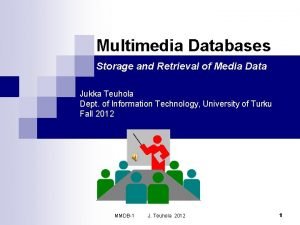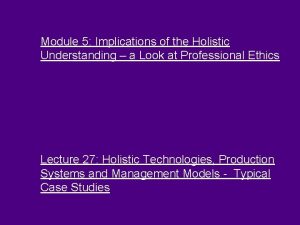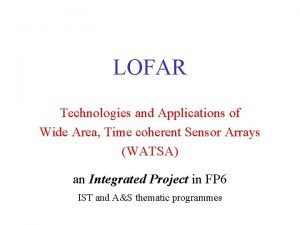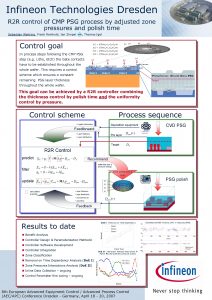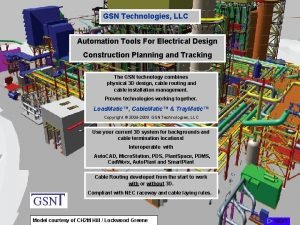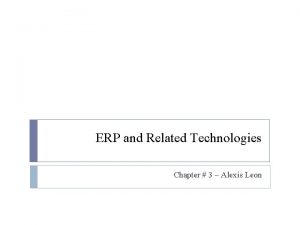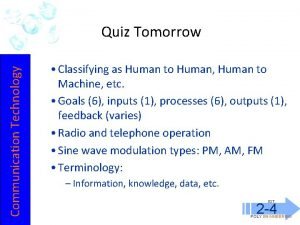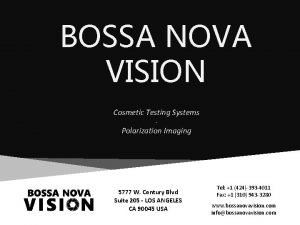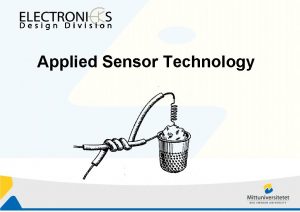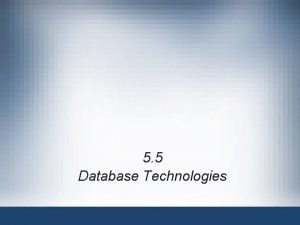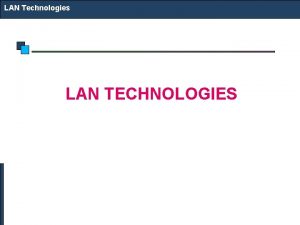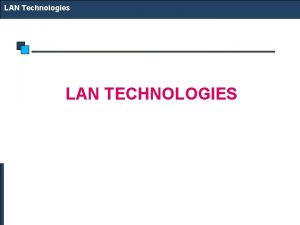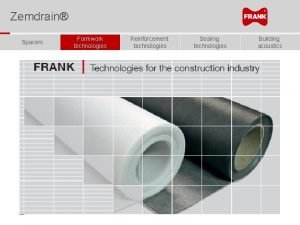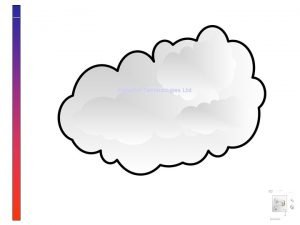Chapter 19 Technology Technologies u u A technology




































































- Slides: 68

Chapter 19 Technology

Technologies u u A technology is a process by which inputs are converted to an output. E. g. labor, a computer, a projector, electricity, and software being combined to produce this lecture.

Technologies u u u Usually several technologies will produce the same product -- a blackboard and chalk can be used instead of a computer and a projector. Which technology is “best”? How do we compare technologies?

Input Bundles u u u xi denotes the amount used of input i; i. e. the level of input i. An input bundle is a vector of the input levels; (x 1, x 2, … , xn). E. g. (x 1, x 2, x 3) = (6, 0, 9× 3).

Production Functions u u y denotes the output level. The technology’s production function states the maximum amount of output possible from an input bundle.

Production Functions One input, one output y = f(x) is the production function. Output Level y’ y’ = f(x’) is the maximal output level obtainable from x’ input units. x’ Input Level x

Technology Sets u A production plan is an input bundle and an output level; (x 1, … , xn, y). u A production plan is feasible if u The collection of all feasible production plans is the technology set.

Technology Sets One input, one output Output Level y’ y” y = f(x) is the production function. y’ = f(x’) is the maximal output level obtainable from x’ input units. y” = f(x’) is an output level that is feasible from x’ input units. x’ x Input Level

Technology Sets The technology set is

Technology Sets One input, one output Output Level y’ The technology set y” x’ Input Level x

Technology Sets One input, one output Output Level Technically efficient plans y’ y” The technology Technically set inefficient plans x’ Input Level x

Technologies with Multiple Inputs u u u What does a technology look like when there is more than one input? The two input case: Input levels are x 1 and x 2. Output level is y. Suppose the production function is

Technologies with Multiple Inputs u E. g. the maximal output level possible from the input bundle (x 1, x 2) = (1, 8) is u And the maximal output level possible from (x 1, x 2) = (8, 8) is

Technologies with Multiple Inputs u The y output unit isoquant is the set of all input bundles that yield (at most) the same output level y.

Isoquants with Two Variable x Inputs 2 yº 8 yº 4 x 1

Isoquants with Two Variable Inputs u More isoquants tell us more about the technology.

Isoquants with Two Variable x Inputs 2 yº 8 yº 6 yº 4 yº 2 x 1

Isoquants with Two Variable Inputs Output, y yº 8 yº 6 x 2 y º 4 yº 2 x 1

Technologies x. Cobb-Douglas 2 All isoquants are hyperbolic, asymptoting to, but never touching any axis. x 1

Fixed-Proportions Technologies u A fixed-proportions production function is of the form u E. g. with

Fixed-Proportions Technologies x 2 x 1 = 2 x 2 7 4 2 4 8 min{x 1, 2 x 2} = 14 min{x 1, 2 x 2} = 8 min{x 1, 2 x 2} = 4 14 x 1

Perfect-Substitutes Technologies u A perfect-substitutes production function is of the form u E. g. with

Perfect-Substitution Technologies x 2 x 1 + 3 x 2 = 18 x 1 + 3 x 2 = 36 x 1 + 3 x 2 = 48 8 6 3 All are linear and parallel 9 18 24 x 1

Marginal (Physical) Products u u The marginal product of input i is the rate-of-change of the output level as the level of input i changes, holding all other input levels fixed. That is,

Marginal (Physical) Products u The marginal product of input i is diminishing if it becomes smaller as the level of input i increases. That is, if

Marginal (Physical) Products E. g. if then and

Marginal (Physical) Products E. g. if then and so

Marginal (Physical) Products E. g. if then and so and

Marginal (Physical) Products E. g. if then and so and Both marginal products are diminishing.

Returns-to-Scale u u Marginal products describe the change in output level as a single input level changes. Returns-to-scale describes how the output level changes as all input levels change in direct proportion (e. g. all input levels doubled, or halved).

Returns-to-Scale If, for any input bundle (x 1, …, xn), then the technology described by the production function f exhibits constant returns-to-scale. E. g. (k = 2) doubling all input levels doubles the output level.

Returns-to-Scale One input, one output Output Level y = f(x) 2 y’ Constant returns-to-scale y’ x’ 2 x’ Input Level x

Returns-to-Scale If, for any input bundle (x 1, …, xn), then the technology exhibits diminishing returns-to-scale. E. g. (k = 2) doubling all input levels less than doubles the output level.

Returns-to-Scale One input, one output Output Level 2 f(x’) y = f(x) f(2 x’) Decreasing returns-to-scale f(x’) x’ 2 x’ Input Level x

Returns-to-Scale If, for any input bundle (x 1, …, xn), then the technology exhibits increasing returns-to-scale. E. g. (k = 2) doubling all input levels more than doubles the output level.

Returns-to-Scale One input, one output Output Level Increasing returns-to-scale y = f(x) f(2 x’) 2 f(x’) x’ 2 x’ Input Level x

Returns-to-Scale u A single technology can ‘locally’ exhibit different returns-to-scale.

Returns-to-Scale One input, one output Output Level y = f(x) Increasing returns-to-scale Decreasing returns-to-scale x Input Level

Examples of Returns-to-Scale The perfect-substitutes production function is Expand all input levels proportionately by k. The output level becomes

Examples of Returns-to-Scale The perfect-substitutes production function is Expand all input levels proportionately by k. The output level becomes

Examples of Returns-to-Scale The perfect-substitutes production function is Expand all input levels proportionately by k. The output level becomes The perfect-substitutes production function exhibits constant returns-to-scale.

Examples of Returns-to-Scale The perfect-complements production function is Expand all input levels proportionately by k. The output level becomes

Examples of Returns-to-Scale The perfect-complements production function is Expand all input levels proportionately by k. The output level becomes

Examples of Returns-to-Scale The perfect-complements production function is Expand all input levels proportionately by k. The output level becomes The perfect-complements production function exhibits constant returns-to-scale.

Examples of Returns-to-Scale The Cobb-Douglas production function is Expand all input levels proportionately by k. The output level becomes

Examples of Returns-to-Scale The Cobb-Douglas production function is Expand all input levels proportionately by k. The output level becomes

Examples of Returns-to-Scale The Cobb-Douglas production function is Expand all input levels proportionately by k. The output level becomes

Examples of Returns-to-Scale The Cobb-Douglas production function is Expand all input levels proportionately by k. The output level becomes

Examples of Returns-to-Scale The Cobb-Douglas production function is The Cobb-Douglas technology’s returnsto-scale is constant if a 1+ … + an = 1

Examples of Returns-to-Scale The Cobb-Douglas production function is The Cobb-Douglas technology’s returnsto-scale is constant if a 1+ … + an = 1 increasing if a 1+ … + an > 1

Examples of Returns-to-Scale The Cobb-Douglas production function is The Cobb-Douglas technology’s returnsto-scale is constant if a 1+ … + an = 1 increasing if a 1+ … + an > 1 decreasing if a 1+ … + an < 1.

Returns-to-Scale u Q: Can a technology exhibit increasing returns-to-scale even though all of its marginal products are diminishing?

Returns-to-Scale u u u Q: Can a technology exhibit increasing returns-to-scale even if all of its marginal products are diminishing? A: Yes. E. g.

Returns-to-Scale u So a technology can exhibit increasing returns-to-scale even if all of its marginal products are diminishing. Why?

Returns-to-Scale u u A marginal product is the rate-ofchange of output as one input level increases, holding all other input levels fixed. Marginal product diminishes because the other input levels are fixed, so the increasing input’s units have each less and less of other inputs with which to work.

Returns-to-Scale u When all input levels are increased proportionately, there need be no diminution of marginal products since each input will always have the same amount of other inputs with which to work. Input productivities need not fall and so returns-to-scale can be constant or increasing.

Technical Rate-of-Substitution u At what rate can a firm substitute one input for another without changing its output level?

Technical Rate-of-Substitution x 2 yº 100 x 1

Technical Rate-of-Substitution x 2 The slope is the rate at which input 2 must be given up as input 1’s level is increased so as not to change the output level. The slope of an isoquant is its technical rate-of-substitution. yº 100 x 1

Technical Rate-of-Substitution is the rate at which input 2 must be given up as input 1 increases so as to keep the output level constant. It is the slope of the isoquant.

Well-Behaved Technologies u A well-behaved technology is – monotonic, and – convex.

Well-Behaved Technologies Monotonicity u y Monotonicity: More of any input generates more output. monotonic x y not monotonic x

Well-Behaved Technologies Convexity u Convexity: If the input bundles x’ and x” both provide y units of output then the mixture tx’ + (1 -t)x” provides at least y units of output, for any 0 < t < 1.

Well-Behaved Technologies Convexity x 2 yº 100 x 1

Well-Behaved Technologies Convexity x 2 yº 100 x 1

Well-Behaved Technologies Convexity x 2 yº 120 yº 100 x 1

Well-Behaved Technologies Convexity x 2 Convexity implies that the TRS increases (becomes less negative) as x 1 increases. x 1

Well-Behaved Technologies higher output x 2 yº 200 yº 50 yº 100 x 1
 E commerce architecture and technologies in web technology
E commerce architecture and technologies in web technology It infrastructure and emerging technologies
It infrastructure and emerging technologies Emerging technology chapter 5
Emerging technology chapter 5 Chapter 5 it infrastructure and emerging technologies
Chapter 5 it infrastructure and emerging technologies Waites wireless
Waites wireless Emergent game technologies
Emergent game technologies Krisent technology
Krisent technology Mobilean technologies
Mobilean technologies Wan technologie
Wan technologie Wan technologies atm
Wan technologies atm Vce theatre studies study design
Vce theatre studies study design Tesca technologies
Tesca technologies Stiesdal energy storage
Stiesdal energy storage Langenburg technologies
Langenburg technologies Spine technologies india pvt ltd
Spine technologies india pvt ltd Sirena technologies
Sirena technologies Genex turbine technologies
Genex turbine technologies Shavlik technologies
Shavlik technologies Savex technologies
Savex technologies Qhr technologies inc
Qhr technologies inc Steam methane reforming ppt
Steam methane reforming ppt Orm technology
Orm technology Sisoft technologies
Sisoft technologies Aim lans
Aim lans Abb power technologies
Abb power technologies Rajshi technologies india private limited
Rajshi technologies india private limited Storage and retrieval technologies in multimedia
Storage and retrieval technologies in multimedia Case studies of typical holistic technologies
Case studies of typical holistic technologies Mcl technologies
Mcl technologies Kittyhawk
Kittyhawk Lyceum of information technologies
Lyceum of information technologies Lucent technologies chip
Lucent technologies chip Lofar technologies
Lofar technologies Wan link options
Wan link options Infineon technologies dresden
Infineon technologies dresden Indus auto technologies
Indus auto technologies Peer inspections a pragmatic view
Peer inspections a pragmatic view Aerohub system
Aerohub system Fuze workstation
Fuze workstation Gsn technologies
Gsn technologies Global med technologies
Global med technologies Global health technologies coalition
Global health technologies coalition Gaia technologies plc
Gaia technologies plc Aws400
Aws400 Erp related technologies
Erp related technologies Explain the architecture of e-commerce
Explain the architecture of e-commerce Dss systems & software technologies ltd
Dss systems & software technologies ltd Dependable technologies
Dependable technologies Marcus radue skyline technologies site: linkedin.com
Marcus radue skyline technologies site: linkedin.com Current trend in media and information include
Current trend in media and information include Hamilton technologies, inc.
Hamilton technologies, inc. Information systems and communication technologies quiz
Information systems and communication technologies quiz Manufacturing and service technologies
Manufacturing and service technologies It infrastructure and emerging technologies
It infrastructure and emerging technologies Group decision support and groupware technologies
Group decision support and groupware technologies Microwave technologies for carrier ethernet services
Microwave technologies for carrier ethernet services Bossa nova vision
Bossa nova vision Omics technology
Omics technology Modern waste management technologies
Modern waste management technologies Stanley assembly tools
Stanley assembly tools Applied sensor technologies
Applied sensor technologies Angelantoni group
Angelantoni group Nrg technologies
Nrg technologies Advanced protection technologies
Advanced protection technologies Sinewave computer services
Sinewave computer services Database connectivity technologies
Database connectivity technologies Proton technologies
Proton technologies Production écrite sur les nouvelles technologies
Production écrite sur les nouvelles technologies Elsinore technologies
Elsinore technologies








